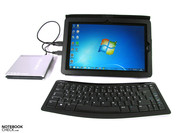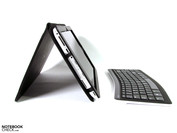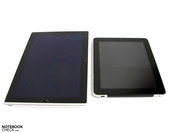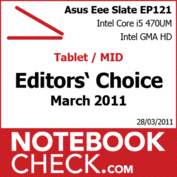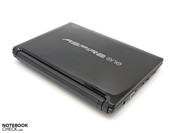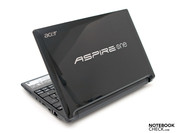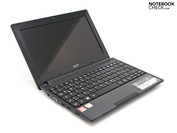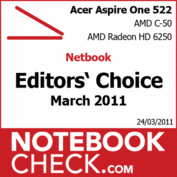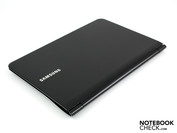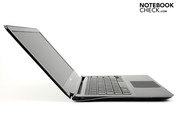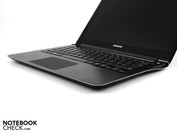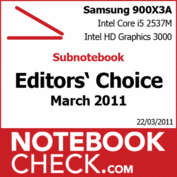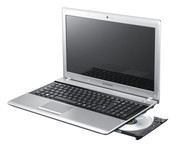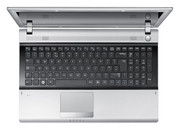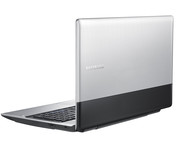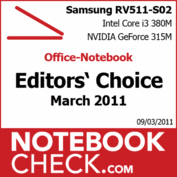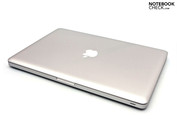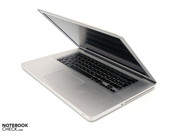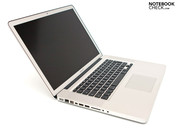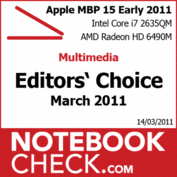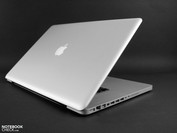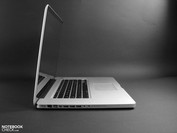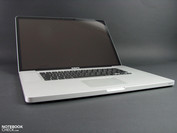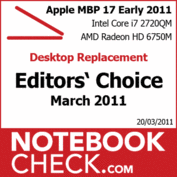Notebookcheck's Best of March 2011
Our editors scrutinized a total of 23 different laptop models last month, among others the new Apple MacBook Pro laptops in different sizes and so also in three different categories. After troubles at the beginning of this year, the new Sandy Bridge processors slowly grow standard and please the user because they successfully balance high performance and energy efficiency. In addition we reviewed some Fusion laptops and AMD seems to be slightly flourishing.
We now compare the reviewed laptops and elect the best of March in each category.
Category Tablet/MID
Contenders:
Acer Iconia Dual Screen
Gigabyte Booktop T1125N
Asus Eee Slate EP121
In the not that strictly defined category of Mobilen Internet Devices (MID) three very different devices compete. Let's start with the Acer Iconia Dual Screen Notebook. After the Toshiba Libretto, which implemented the same concept in a small size, Acer now tries to place a big laptop with two touchscreens in the market. The idea sounds interesting, but the notebook could not really convince in "every day use". It seems that the second horizontal display does not bring that many new fields of application to justify the loss of keyboard and touchpad. However, this is also a matter of software and Windows 7 is simply not the ideal choice.
The concept of the Gigabyte Booktops is very interesting: The standard Convertible, i.e. a mix of laptop and tablet with a special display hinge, tries to convince also in stationary use by a special docking solution. The concept proved to have pros in our test, but the tester did not achieve a better total rating because of some points of critique (viewing angles, battery life,...).
Last but not least also Asus had a contender with an concept of its own in this group. The answer to booming tablets and their disadvantages in editing text is called Eee Slate EP121: A 12-inch Tablet-PC with Windows operating system, which can turn into a fully-fledged PC with a keyboard.
Tablet/MID of March 2011: Asus Eee Slate EP121
Although joining the best of the laptop and tablet world sounds particularly revolutionary, Asus is one of the first notable manufacturers to offer such a product. Those who do not know whether they prefer a netbook or a tablet, could definitely consider this laptop. Although Windows does not seem to be the ideal operating system for tablets, it is a familiar environment for many users, who profit from the full software compatibility - in this aspect Android-based solutions usually cannot compete.
Shortcut:
What we like
The vast functionality with relatively high system performance and the very good display.
What we'd like to see
An AR coated display surface, smoother USB ports and UMTS.
What surprises us
That Asus installs so many functions in a nevertheless quite portable device, treats it with a top notch display and delivers good manufacturing quality.
The competition
It usually is at an advantage in view of mobility. The combination of display size, display quality and system performance can't yet be supplied by any other manufacturer.
Category Netbook
Contenders:
HP Pavilion dm1-3180eg
Acer Aspire One 522
Packard Bell dot SE
Sony Vaio VPC-YB1S1E/S
Slowly but surely the netbook hype calms down. Sporadically, manufacturers release smaller updates, but innovative new device are rare. An exception is the HP Pavilion dm1, which attracts attention by using the AMD Fusion technology, i.e., a dual core CPU and a dedicated graphics solution. Although the graphics performance is better compared to Intel Atom systems, it remains on a netbook level.
Acer also uses AMD's Fusion in its new Aspire One 522 netbook. But, they choose the weakest solution available, the C-50 APU. The display is exciting: Its resolution of 1280x720 pixel emphasizes that the device is HD-capable, an advantage considered it is a netbook.
Packard Bell considered look more important than technology in designing the dot SE netbook. The dwarf uses typical netbook hardware, Intel Atom N550 and GMA 3150 graphics. Many colors, among others bright pink, are yet not sufficient to attract customers.
Based on the AMD's Fusion Technology, the Sonys Vaio YB1 combines a small C-50 APU and a rather powerful graphics card and, so, it is difficult to decide whether it is still a netbook or already a subnotebook. It has an attractive case, a bright display and a good battery life, but a low application performance, a heavily reflecting display and an always very audible fan. By the way, the later seems to be a problem many Fusion devices appear to struggle with.
Netbook of March 2011: Acer Aspire One 522
Achieving a total rating of 85% ("good"), the Aspire One 522 proves to be clearly better than the other nebooks we reviewed. Besides a well-manufactured case, good input devices, a low weight, a good battery life of 5-7 hours and moderate emissions contribute to this. The display shines with a high resolution, but could be brighter, in particular for mobile use. The glare-type surface of the display is also not really appropriate for this purpose.
Netbook-Users who like multimedia could definitely take a closer look, even more, because of the attractive entry price: it is available from 300 euro.
Shortcut:
What we like
The still elegant, albeit susceptible, case, the new AMD C-50 APU and the display's native resolution of 1280x720 pixels.
What we'd like to see
A better office performance, respectively a 2 GB RAM ex-factory, a larger scope of delivery and a longer warranty period (24 months).
What surprises us
The comparatively short battery life of 6 hours and 37 minutes in idle. It's only about 5 hours in routine use.
The competition
For example: the Acer Aspire One D255 with an Intel Atom N550 from the own range, the Toshiba NB550D with almost identical hardware configuration and the Samsung NF310 with a matt HD range.
Category Subnotebook
Contenders:
Asus U36JC-RX081V
Samsung 900X3A
Apple MacBook Pro 13 Early 2011
Subnotebooks are slightly bigger and above all more powerful than netbooks. These mobile computers have a size of 11 to 13 inch and are equipped with more powerful processors, which are not or hardly restrictive compared to full-grown laptops. Often such focusing on multimedia are even equipped with dedicated graphics cards. Nevertheless, mobility, i.e. battery life and weight, is the most important aspect here.
Let's start with the Asus U36JC, a slim 13-incher, which particularly wants to convince with an attractive look. Although the laptop still has to do without Sandy Bridge, the U36JC can nearly completely convince, which is reflected in the very good total score of 86%. Decent performance, long battery life, and a weight of only 1.7 kilogram, clearly militate in favor of the U36JC. The biggest point of critique: the reflecting display with moderate brightness, which cannot convince outdoors.
Samsung hit the mark with the 900X3A in this category, but not with its name. Because of a case from high-quality aluminum, a total weight of only 1.4 kilogram, the high-quality display with matte surface and best possible brightness, good performance with Intel's Sandy Bridge processor and a battery life between 5 and 9 hours there is no doubt about it. But, you need to have the necessary cash: You'll need to spend 1600 euro if you want to own the 900X3A, one of the most interesting notebooks at the time of writing.
We curiously looked forward to reviewing the Apple MacBook Pro 13, the smallest member of the Pro series. The qualities of the aluminum MacBook conform to the usual level and our expectations. But, regarding hardware components Apple reaches the upper level of what is possible inside such a small case - more than ever before.
Subnotebook of March 2011: Samsung 900X3A
The clearest and therewith easiest decision is the election of the Samsung 900X3A as it was superior in nearly all aspects. Besides that docking port and HDMI interface are missing, only the steep price could hold you off from buying: Quality has its price!
Shortcut:
What we like
Once again, the accurate deployment of an SSD shows what potential can be drawn out of a mediocre system with ULV CPU.
What we'd like to see
To stay stylish, more ports don't have to be installed into the chassis. A native docking that make plugging and unplugging superfluous could make such a subnotebook perfect.
What surprises us
We've never had such a bright TFT in our assessments.
The competition
Sandy Bridge subnotebook power isn't yet available from other manufacturers. Acer Travelmate 8372 and Aspire 3820, Dell Vostro V130, Samsung QX310 all have inferior displays; Sony Vaio S13 and Apple MacBook Air aren't as expensive; Sony Vaio VPC-Z13Z9E: Fast SSD, very expensive; Vaio VPC-Z13B7E: inexpensive model without SSD; Lenovo IdeaPad U260: Stylish for little money.
Category Office
Contenders:
Acer Aspire 5253
Samsung RV511-S02
Sony Vaio VPC-EB3E4E/WI
Samsung R730-JT06
Schenker Xesia E510 Entry
In this category cheap entry-level notebooks, most of them without dedicated graphics card, and well-known business laptops with an essentially higher price and special qualities in terms of durability and security gather together. In March we had mainly representatives of the first range under review.
The Acer Aspire 5253 sticks out with a special feature: It is based on AMD's Fusion. Equipped with E-350 APU the 15-incher uses the same processor as the HP Pavilion dm1 mentioned above. So, cooling is easy and the Acer Aspire 5253's soundscape stays low. A con is the low application performance. But, the useable battery life is at least partly able to compensate for this.
The Samsung RV511 could be the right notebook for users with a strong focus on Office work. Its matte display goes easy on the eyes even when working concentrated for hours. Furthermore, it scores points because of its low emissions. Office users won't need a better contrast, but, they have to accept that the case is just moderately stable. The low price makes it easier: from about 500 euro (400 euro with IGP)
Sony tries to attract customers looking for a particularly cheap notebook with the Vaio EB3E4E. But, you won't get much more that an Intel Pentium entry-level CPU, integrated graphics processor (IGP), run-of-the-mill display and a short battery life of about two hours for 600 Euro.
Samsung has a notebook for price-conscious customers who prefer a bigger display on offer: the Samsung das R730. Being equipped with Intel Core i3 CPU and Nvidia Geforce 310M it can merely cover the basics. But, the users profits from the higher resolution of the display.
If you do not want to spend much money, the German Schenker Notebook also offers an appropriate laptop, the Xesia E510. Although there are a couple of CPUs, RAM options and hard disks to choose from, the real strength of the Xesia is its low price and the matte display (from 449 Euro). However, the price can rise depending on the selected configuration.
Office-Notebook of March 2011: Samsung RV511-S02
Samsung scores again. Although the RV511 is surely not faultless, the bundles appears to be very interesting to us. At an attractive price it combines an ergonomic, matte screen with respectable hardware. You have to ignore some restrictions of the case, but, the competition in this price range can not do better, too.
Shortcut:
What we like
The matte LCD screen and the once again successful Silent Mode.
What we'd like to see
A sturdier case and non-reflective keyboard surface.
What surprises us
A 3-hour battery life without Optimus.
The competition
Fujitsu LifeBook A530: Pentium, Core i3/i5; Lenovo IdeaPad G560: also i3-CPU; HP 625: matte but weaker; HP 620: sturdy and simple design; HP Compaq Presario CQ62: consumer notebook, weaker performance; MSI CR630: single-core AMD; Asus X52F-EX513D: Pentium bargain notebook starting at 330 Euro; Samsung R540: inexpensive with i3-370M; Toshiba Satellite Pro L670-170: matte screen, 17"; HP ProBook 4720s: matte screen, 17"; Asus A52JU: small HD 6370 GPU; Lenovo B560: with Optimus for 399 Euro
Category Multimedia
Contenders:
Sony Vaio VPC-EB4X1E/BQ
Sony Vaio VPC-F13L8E/H
Schenker XMG A501
Apple MacBook Pro 15 Early 2011
Packard Bell EasyNote LS11
Multimedia laptops focus more on performance than price. A powerful graphics is especially important in this category. Sony is traditionally highly present in the multimedia range. So, it's not surprising that there are two Japanese contenders. Although the EB4X1E, which costs 800 euro, uses a dated i5-480M CPU and a ATI HD5650 graphics solution, it has an important pro: The built-in Full-HD screen does not only convince with its resolution. Brightness and color representation are also above-average in the price range.
Its colleague from Sony, the F13L8E (16-Zoll) is a little bigger and also slightly more expensive (about 900 euro). It also uses a Full-HD Display and the performance is on par with the Vaio EB4.
Schenker Notebook, who are well-known for their powerful gaming machines, also offers a device in this category. The XMG A501 can be equipped with Intel's current Sandy Bridge CPUs up to quad core chips. Together with an Nvidia GT 540M graphics card these ensure a good system performance. It can even cope with current games. Considering the hardware the HD+ display (1600x900) is a good choice and it convinces with its matte surface.
Apple's representative of the multimedia category is called MacBook Pro 15. In current configurations it is equipped with Intel's Sandy Bridge processors and AMD graphics chips (HD 6490M or HD 6750M). First-class performance appears to be guaranteed, but only under MacOS. Under Windows the built-in hardware cannot unfold its full potential. Die-hard Mac users won't mind. This is hopefully also true for the price. The game starts at steep 1749 euro and if you select powerful components the price can quickly exceed 2000.- euros.
Our last contender is the Packard Bell LS11. The 17-incher tries to score points with an especially low price of about 700 euro. You'll find a i5-2410M Sandy Bridge CPU and an AMD Radeon HD 6650M mid-range graphics inside. In view of the price, (unimportant) restrictions regarding display and connectivity do not surprise.
Multimedia laptop of March 2011: Apple MacBook Pro 15 Early 2011
The sub-ratings in this category only allow one logical conclusion. The current release of the Apple MBP 15 inherited the strength of the series and the performance even improved. Nevertheless, Apple also reached the limits of the cooling capacities in the small 15-inch unibody chassis.
Shortcut:
What we like
The once-again perfect aluminum unibody case, the timeless design and Thunderbolt port, although there aren't many devices that can be connected with it yet.
What we'd like to see
A lower starting price or longer standard warranty of at least 24 months. The extended warranty is shamelessly expensive.
What surprises us
The time-tested case design is kept in its entirety with no options regarding what material the case consists of or the input devices.
The competition
Because of the Sandy Bridge chipset defect, the release of comparable laptops is lagging. The successors to high-end notebooks like the Sony VAIO VPC-Z13Z9E or HP Envy 15 will make for some good competition once released.
Category Gaming / DTR
Contenders:
Eurocom Racer
HP Envy 17-1190eg
Apple MacBook Pro 17 Early 2011
If you are looking for performance on desktop level, a big display and extensive connectivity you'll find such in desktop replacement notebook or special gaming machines. The Eurocm Racer reviewed in March might appear quite exotic in our region. However, its an already well-known device, the P150HM Barebone from Clevo, which is also offered by Schenker Notebook and Deviltech in Germany. The small 15-incher is equipped with an AMD Radeon HD 6970M and an Intel 2720QM CPU. So, it is quite well equipped for gaming. Con: The high noise level under load.
HP sooner wants to attract rich and design-oriented consumers than gaming enthusiasts with the Envy 17. Its hardware, Intel 720QM CPU and ATI's Mobility Radeon HD 5850 graphics already seems to be somewhat dated. In addition, it has to cope with restrictions typical for DTR laptops: weight, noise, and battery life.
If you love successful design and are ready to spend really much money, there is no way around the biggest Apple MacBook Pro in 17-inch size. You'll get a solid and elegant aluminium case, high performance and a high-quality display for more than 2000 euro. However, compared to the Windows world, the expensive notebook has to be criticized in some aspects: e.g, only 12 month warranty ex factory, no UMTS, no USB-3.0, and a fixed battery. But, Mac users with high demands on performance won't have another choice.
DTR Laptop of March 2011: Apple MacBook Pro 17 Early 2011
Under MacOS the MBP 17 shines with an amazing balance between mobility (battery life) and performance. In the Windows world, you won't find any notebook with comparable performance which can run more than 8 hours on battery. If money is not the most important factor, and, choosing an Apple product, it shouldn't be, you'll get a sophisticated multimedia package. The Envy 17, which is often said to be the Windows competitor, is outperformed by the MBP 17 in nearly every aspect. The battery life is impressive again: 8-13h vs. 1-2 hours of the Envy 17 speak for themselves.
Shortcut:
What we like
The unique combination of (usually) mutually exclusive characteristics like mobility, battery life and a powerful performance.
What we'd like to see
Much better Windows support and ports like UMTS, which frustratingly continue to be left out. Luckily, a matte screen is available, albeit at a higher price.
What surprises us
That Apple designed the power supply to barely withstand maximum system demands. That the MBP 17 handles Mac OS X much better than Windows is just the nature of the beast.
The competition
Considering the sum of all parts, the quality of the MBP 17 at best only comes close to being matched in the 17" laptop segment. A real-world 7-hour battery life in a 3-Kg form and very good performance is previously unheard of. Taking away one characteristic or another, some alternatives do pop up like the HP Envy 17, HP EliteBook 8740w, Dell Precision M6500, Lenovo Thinkpad W701 and Samsung E372.




